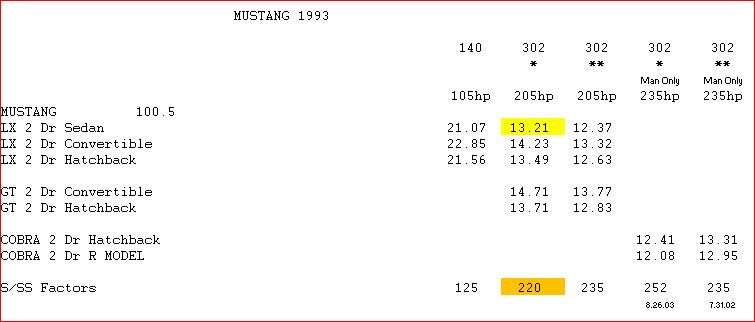You will need to locate two important pieces of information. First, locate and download the "Stock Car Classification Guide" for the particular car you are considering from NHRA's website - NHRA Classification Guides . They have arranged the links to the individual guide sheets by manufacturer and year. (Note - If you do not find a guide sheet for the car-engine you are considering, then that particular combination is not accepted for competition by the NHRA.) Second, you will need a list of the Stock and Super Stock classes and their associated power-to-weight factor ranges or "weight breaks". A consolidated list of these classes and weight breaks can be found here - ClassRacerInfo.com List of Classes or here - ClassRacer.com Classes.
With these pieces of information located, the next step is to locate the particular car you are considering on the NHRA Classification Guide sheet. The class guide sheets are organized as charts with the cars listed on the left side of the sheet in order by model and body style. For the example here we are using a 1993 Ford Mustang as shown below.

The LX 2-dr with a 205hp 302 has a power to weight factor of 13.21 (note the box highlighted in yellow). The NHRA power factor for this engine is 220 (note the box highlighted in orange). By multiplying the power to weight factor by the power factor, you calculate the shipping weight. (13.21 x 220 = 2906.2 lbs.) With this data, we can refer to the classes chart and find that this Mustang will be classified in 'K' Stock (13.00 to 13.49 lbs/hp) or 'L' Super Stock (13.00 to 13.99 lbs/hp). However, the racing associations allow the weight of the car to be adjusted to the minimum for the car to still have a power to weight factor of 13.00. So, the actual 'class' weight of the car for either class will be 13.00 x 220 = 2860 lbs. At the races, the cars are weighed to insure fairness but the cars are weighed with the driver in the car and an additional 170 lbs. is added to the 'class' weight to allow for the driver. So the actual 'race' weight of our Mustang will be 2860 + 170 = 3030 lbs.
The racing associations also allow for weight to be added to the car to make the car heavy enough to race in the next class in the list. For Stock eliminator, the next class is 'L' at 13.50 to 13.99 lbs/hp. So you could add enough weight to the car to weigh 13.5 x 220 = 2970 lbs + 170 lbs or 3140 lbs and compete in 'L' Stock. For Super Stock, the next heavier class is 'M' at 14 lbs/hp so the weight for the Mustang for that class is 14 x 220 = 3080 lbs + 170 lbs = 3250 lbs.
Finally, the racing associations also allow for additional weight to be removed from the car to compete in the next class in the list with a lower power to weight factor. For Stock eliminator the next class is 'J' at 12.50 to 12.99 lbs/hp and the race weight would be 12.50 x 220 = 2750 lbs + 170 lbs for the driver = 2920 lbs. For Super Stock, the next class is 'K' at 12.00 to 12.99 lbs/hp. The weight to compete for this class is 12 x 220 = 2640 lbs + 170 = 2810 lbs.
This process is required for every consideration of any car in the class guides. So the math is laborious. And we have not even touched on the fact that the power factor will change if aftermarket cylinder heads are allowed for the engine. If that is the case, then these calculations must be repeated for every series of classes.
OR, you can register for ClassRacerInfo.com and just click your mouse and let the tool do the work for you!
The fundamental goal for class racing for Stock or Super Stock Eliminator competition is to have competitors in a class be somewhat equal in performance potential. To construct a means to group cars on an equitable scale, the first level of consideration is that in the case of two like cars, the car with the bigger engine will be faster. Also, in the case of two different cars having the same engine, the lighter car will have an advantage in an acceleration match. That's basic physics - the more power or less weight, the faster you are. A reasonable approach then would be to group cars with similar power-to-weight ratios and they should have similar acceleration characteristics, based on the basic rule of physics. Since there is a somewhat standard measure of power that all automobile manufacturers adhere to when rating their engines, the basis for a power-to-weight ratio classification system is thus available. This is basically how Stock and Super Stock 'class' racing was born.